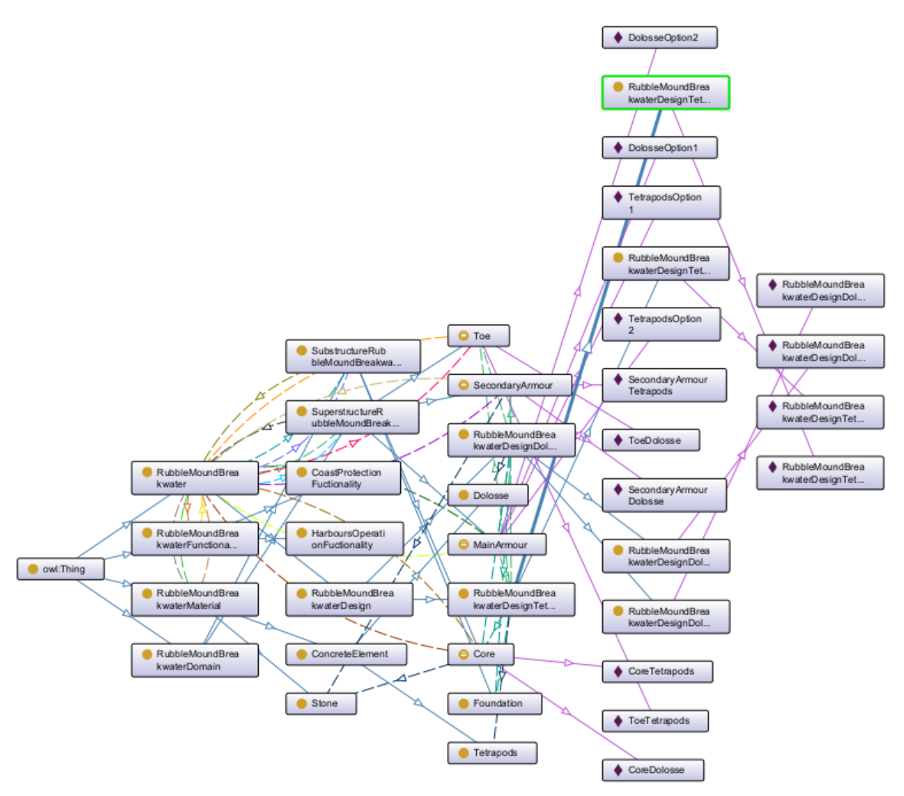Introduction
Breakwaters are coastal structures designed to protect shorelines from flooding and erosion while enabling harbour activities. Among these, Rubble Mound Breakwaters are constructed with a core of quarry run, shielded from wave action by one or more layers of large stones or specially shaped concrete armour units.
A rubble mound breakwater can also include a parapet wall, built with reinforced concrete, serving two primary purposes: facilitating the safe transit of people and vehicles and mitigating overtopping during storm events.
This report presents the development of an ontology for Rubble Mound Breakwaters, focusing on key concepts required for their preliminary structural design. The purpose of this ontology is to provide a representation of the physical components, materials, functionalities, and interrelations that are essential in the structural design process.
Defining the main dimensions of the breakwater components is the first step in the design, as it allows for the estimation of the structure’s budget cost and the comparison of different design options. This ontology supports these processes by organizing the knowledge needed to define and evaluate design parameters effectively.
The scope of this ontology includes the structural, functional, and logical components associated with rubble mound breakwaters, as identified through an extensive literature review. By connecting these elements, the ontology facilitates a better understanding of the structure, essential for the design.
The intended users of this ontology are structural engineers specializing in breakwater design. It is designed to facilitate a better understanding and connection of key concepts, supporting the design decisions and improving the efficiency of structural analysis and design processes. The intended use of the ontology is to assist structural engineers in tasks such as defining structural elements and exploring design options to then continue with a more detailed design.
Class Hierarchy
An ontology was built using Protégé and it organizes concepts into hierarchical classes and object properties, defining the relationships between breakwater components. The key elements defined in the ontology were:
- Components: Breakwaters consist of a superstructure (armour layers, toe and parapet walls) and a substructure (core and foundation).
- Materials: Includes natural stones and concrete elements such as Tetrapods and Dolosse.
- Functions: Breakwaters provide coastal protection and enable harbor operations. It can also facilitate the safe transit of people and vehicles.
Here are the main classes and their subclasses to provide a clear overview of how a flood retention basin operates and its key components.
Ontograph
To view the ontology in protégé, the OntoGraf plug-in is used. After creating the classes, hierarchy, and defining their relationships with axiomatic examples, we developed an ontology visualization for the rubble mound breakwater, as shown in the figure below.
Engineering Examples
Here are three engineering examples with their specific scenario and use case:
1. Design of a Breakwater for a New Port:
Scenario: A breakwater must be designed to ensure the operation of container ships in the new port in harsh marine conditions. The city lacks nearby quarries for stone extraction, so concrete elements are preferred to reduce costs.
Use Case: The ontology provides information on different physical components of the breakwater and their materials. Engineers can test different configurations, such as varying the concrete armour elements considering different shapes and sizes, and analyze how these changes impact the structure. Additionally, this insight can be used to design a parametric model for structural and durability analysis.
2. Repairs on a Breakwater:
Scenario: After an extraordinary storm hits the city, repairs must be made to the breakwater to restore port operations, which is a critical economic activity.
Use Case: The ontology offers insight on which dimensions need to be prioritized for repair and the different design options, such as using various materials and shapes. This information can be used to develop a parametric model for structural analysis of the new structure, incorporating both old and new elements of the repaired components.
3. Modification of an Existing Structure for New Loads:
Scenario: Many breakwaters were designed under assumptions that no longer hold, given the increasing frequency and intensity of storms due to climate change. The structure must be redesigned for the new and future context.
Use Case: Engineers can consult the ontology to understand the structural implications of the wave action and the impact of the climate change and to determine which dimensions and materials need to be modified according to the new loads. This information can be used to create a parametric model, including projected storm data, to study the structure behavior, strength, and durability.

